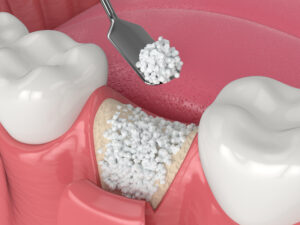
If you have suffered from a condition that led to reduced bone density in the jaw, have had significant trauma to your face or jaw, or are simply getting a dental implant following an extraction or other oral procedure, your dentist, periodontist, or oral surgeon may recommend a dental bone graft.
Dental bone grafting is a common procedure with an incredibly high success rate. Here are some of the questions we commonly receive about dental bone grafts.
What Is a Dental Bone Graft?
While many different types of bone grafts are used for various reasons, dental bone grafts are generally used to maintain or restore jaw density at the site of an extraction or the future site of a dental implant. Depending on the size and severity of the bone deterioration at the grafting site, either small particles of bone material or larger pieces of whole bone are implanted into the jaw and covered with a protective membrane.
Over the following weeks, your body will use the implanted bone or bone particles as a structural framework for building new bone, eventually providing a robust and secure site for a dental implant or dentures.
What Are the Types of Dental Bone Grafts?
There are four main types of dental bone grafts:
- Socket preservation: These grafts are performed immediately following the extraction of a tooth. The graft material fills in the hole left behind when the tooth is removed and prevents the sides of the socket from collapsing and filling the void. These grafts are sometimes called “ridge preservation” grafts.
- Ridge augmentation: If it’s been a while since a tooth or teeth were removed or lost, the jawbone beneath the empty sockets may have deteriorated and become thinner over time. A ridge augmentation graft adds bone volume to the site to provide a stable base for an implant or other restoration.
- Periodontal bone graft: If you suffer from gum disease, the bone supporting your teeth can erode and cause teeth to become loose. If this happens, a periodontal graft can implant tissue around the teeth, supporting and preventing the tooth from moving in the jaw.
- Sinus lift: In cases where the upper back teeth are missing, the maxillary sinuses can drop into the space formerly occupied by the roots of these teeth, making implants impossible without piercing the sinus membrane. The sinus is lifted back into place during the procedure, and a dental bone graft is performed to provide a foundation for implants.

Where Does the Bone Come From?
If you’re receiving a more minor, particulate graft, the bone material may come from a number of sources, including animal or cadaver bone tissue. In these cases, the donor bone is thoroughly sterilized and cleaned to remove soft tissue and ground into tiny particles resembling sand or salt.
It’s important to note here that the “bone” implanted during a dental graft isn’t a “transplant” because no living tissue is implanted. All that remains after the cleaning of the donor bone is the calcium structure.
In the event of a larger graft, called a “block bone” graft, bone is taken from other areas of the jaw or chin and used to build up the affected site. If an even larger graft is needed, bone tissue can be taken from your hip, skull, or shin bone.
Is a Dental Bone Graft Painful?
Particulate bone grafts are a relatively minor procedure, and some dentists will perform the procedure with just a shot of novocaine, like getting a filling. Most of the time, you will be sedated with nitrous oxide or an oral sedative like lorazepam. After the procedure, providers typically prescribe painkillers to help you stay comfortable during healing.
If a block bone graft is required, you may be given deeper anesthesia, and your recovery will typically involve a little more discomfort as your body is healing both the grafting site and the site from which the bone was taken.
What Happens Before the Grafting Procedure?
Before starting a dental bone graft, your dentist, periodontist, or oral surgeon will examine your teeth, gums, and jaw. X-rays or other scans will be used to see the severity of the site’s bone loss. Following that, they will develop a personalized treatment plan to address the issues uncovered in the exam and scans.
How Long Does It Take to Recover From a Dental Bone Graft?
You’ll probably begin to feel back to normal within a week or two of your bone graft procedure, but full recovery from a graft can take anywhere from three to nine months, depending on the type of graft, its location, and how quickly your body heals itself after sustaining a wound.
What Are the Risks of Dental Bone Grafting?
While most dental bone grafts are successful, there is a chance that the graft could fail, requiring additional grafts or a reevaluation of your dental health plans. As with any surgical procedure, a dental bone graft carries the risk of infection, bleeding, nerve damage, or complications from anesthesia, but these are relatively rare.
Still Have Questions About Dental Bone Grafting? Talk to Athens Oral Surgery today.
Dr. Tomlinson can assess your oral health, determine whether you need a dental bone graft, and guide you through treatment. Schedule an appointment with our team by calling 706-549-5033.
Related Articles:
